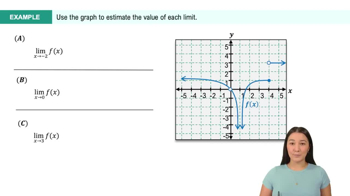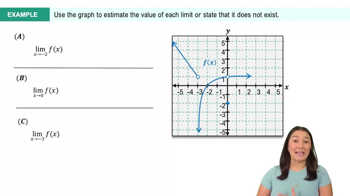Table of contents
- 0. Functions7h 52m
- Introduction to Functions16m
- Piecewise Functions10m
- Properties of Functions9m
- Common Functions1h 8m
- Transformations5m
- Combining Functions27m
- Exponent rules32m
- Exponential Functions28m
- Logarithmic Functions24m
- Properties of Logarithms34m
- Exponential & Logarithmic Equations35m
- Introduction to Trigonometric Functions38m
- Graphs of Trigonometric Functions44m
- Trigonometric Identities47m
- Inverse Trigonometric Functions48m
- 1. Limits and Continuity2h 2m
- 2. Intro to Derivatives1h 33m
- 3. Techniques of Differentiation3h 18m
- 4. Applications of Derivatives2h 38m
- 5. Graphical Applications of Derivatives6h 2m
- 6. Derivatives of Inverse, Exponential, & Logarithmic Functions2h 37m
- 7. Antiderivatives & Indefinite Integrals1h 26m
1. Limits and Continuity
Introduction to Limits
Problem 2.7.47
Textbook Question
Use the precise definition of infinite limits to prove the following limits.
 Verified step by step guidance
Verified step by step guidance1
Step 1: Understand the definition of an infinite limit. The limit of a function f(x) as x approaches a value c is infinity if for every positive number M, there exists a δ > 0 such that if 0 < |x - c| < δ, then f(x) > M.
Step 2: Identify the function and the point of interest. Here, the function is f(x) = \( \frac{1}{x^2} + 1 \) and we are interested in the behavior as x approaches 0.
Step 3: Set up the inequality based on the definition. We need to show that for every M > 0, there exists a δ > 0 such that if 0 < |x| < δ, then \( \frac{1}{x^2} + 1 > M \).
Step 4: Simplify the inequality \( \frac{1}{x^2} + 1 > M \) to \( \frac{1}{x^2} > M - 1 \). This implies \( x^2 < \frac{1}{M - 1} \) and thus |x| < \( \frac{1}{\sqrt{M - 1}} \).
Step 5: Choose δ = \( \frac{1}{\sqrt{M - 1}} \). This choice of δ ensures that whenever 0 < |x| < δ, the inequality \( \frac{1}{x^2} + 1 > M \) holds, proving the limit is infinity.
Recommended similar problem, with video answer:
 Verified Solution
Verified SolutionThis video solution was recommended by our tutors as helpful for the problem above
Video duration:
6mPlay a video:
Was this helpful?

 6:47m
6:47mWatch next
Master Finding Limits Numerically and Graphically with a bite sized video explanation from Callie
Start learning





